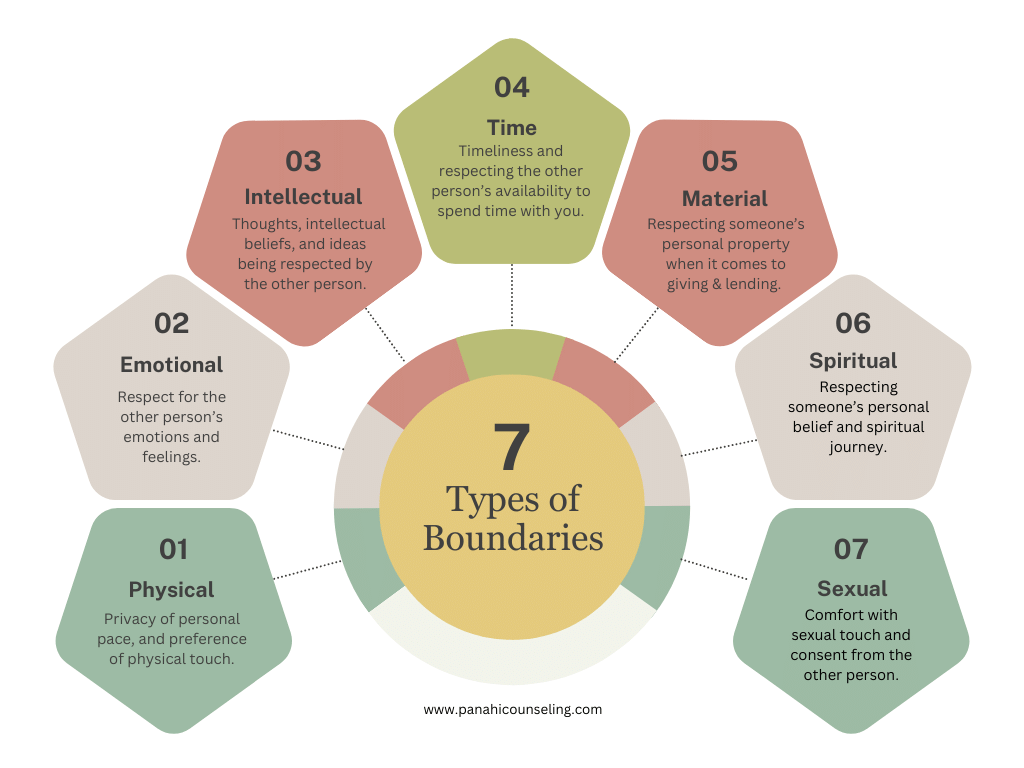In the intricate dance of human connections, there exists an invisible but vital force that plays a pivotal role in the harmony and longevity of any relationship—boundaries. These intangible lines demarcate the space where our individuality meets the shared space of a partnership, be it with a partner, family member, friend, or colleague. Simply put, if you want your relationships to be enjoyable and long lasting, you need to have healthy boundaries.
"Setting boundaries is not about creating walls but about building bridges, fostering deeper connections, and ultimately saving your most cherished relationships."
Boundaries, in the context of relationships, are like the unwritten rules that govern the terms of engagement between individuals. They define the extent to which we allow others into our lives, how we communicate, and where we draw the line when it comes to our personal space, emotions, and needs. Essentially, boundaries are the navigational aids that guide us through the complex terrain of human connections.
Maintaining relationships is not merely about coexisting but thriving together. Just as a gardener tends to their garden to ensure its flourishing, nurturing healthy and balanced relationships requires constant care and attention. A partnership marked by mutual respect, trust, and support is a source of profound fulfillment, while strained relationships can lead to stress, conflicts, and emotional turmoil.

It’s imperative to distinguish between healthy and unhealthy boundaries to ensure that our relationships are nurturing rather than detrimental. Healthy boundaries are flexible yet firm, allowing for emotional intimacy while respecting individual autonomy. They create a safe space for expressing thoughts and feelings without judgment or fear.
On the other hand, unhealthy boundaries may manifest as overly rigid barriers that stifle emotional connection, or as excessively porous boundaries that lead to emotional enmeshment and codependency. Recognizing these distinctions is vital to maintaining balanced and fulfilling relationships.
5 Signs of Unhealthy Boundaries
While understanding the benefits of healthy boundaries is essential, it’s equally crucial to recognize the signs of unhealthy boundaries that can plague your relationships. These signs serve as warning lights on the path to potential conflicts and complications.
1. Overstepping Personal Space:
Overstepping personal space manifests as an invasion of physical or emotional boundaries. It could be someone consistently borrowing personal items without asking, insisting on constant togetherness, or prying into your personal life without your consent. When personal space boundaries are violated, it can lead to feelings of suffocation, resentment, and a loss of autonomy. Over time, this can result in emotional withdrawal or even the complete breakdown of the relationship.
2. Difficulty Saying No:
People with weak boundaries often find it challenging to say no, even when they want to. They may feel obligated to agree to requests or activities that they’re not comfortable with, leading to resentment and burnout. The inability to say no can result in exhaustion, stress, and emotional strain. This can also lead to unfulfilled promises and unmet expectations, which can erode trust in the relationship.
3. Emotional Enmeshment:
Emotional enmeshment occurs when there is an unhealthy level of emotional dependence on another person. This might involve relying on one person for all emotional support, not having personal emotional boundaries, or feeling responsible for someone else’s emotions. Emotional enmeshment can lead to codependency and an unhealthy dynamic where one person’s well-being becomes dependent on the other. This can stifle personal growth and cause resentment when the enmeshment is not reciprocated.
4. Ignoring Red Flags:
Ignoring red flags involves overlooking problematic behavior in the name of keeping the peace or maintaining the relationship. This could include tolerating disrespectful comments, tolerating emotional or physical abuse, or rationalizing negative actions. Ignoring red flags can lead to a toxic and potentially dangerous situation. It perpetuates unhealthy behavior and can ultimately cause severe harm to your well-being and safety.
5. Emotional Manipulation:
Emotional manipulation involves tactics such as guilt-tripping, gaslighting, or emotional blackmail to control or influence another person’s thoughts or behavior. While for a moment the person may manipulate to get what they want, the other partner will become resentful and will detach themselves from the relationship.
The Three Benefits of Setting Healthy Boundaries
Now that we’ve established a foundational understanding of what boundaries are and why they matter, let’s dive deeper into the profound benefits that come with setting healthy boundaries in your relationships. These invisible lines not only serve as protectors but also as catalysts for nurturing and strengthening the bonds you hold dear.
1. Enhancing Communication and Trust:
One of the most significant advantages of setting healthy boundaries is the positive impact on communication and trust within your relationships. When boundaries are clear and respected, open and honest communication can flourish. Here’s how:
- Clear Expectations: Boundaries provide a roadmap for interaction, making it easier for both parties to understand each other’s needs, desires, and limits. This clarity fosters more effective communication and minimizes misunderstandings.
- Trust Building: Trust is the cornerstone of any strong relationship. When boundaries are in place and upheld, trust naturally grows. Knowing that your boundaries will be respected creates a sense of security and reliability.
- Conflict Resolution: Boundaries also play a crucial role in conflict resolution. In disagreements or disputes, the presence of established boundaries can help guide discussions, ensuring that conversations remain respectful and focused on resolving issues.
2. Maintaining Individuality and Self-Esteem:
In the journey of a relationship, it’s easy to lose sight of your individuality. Healthy boundaries act as guardians of your unique identity and self-esteem:
- Preserving Individual Space: Setting boundaries allows you to maintain your personal space, both physically and emotionally. This space is essential for nurturing your own interests, passions, and well-being, which, in turn, makes you a more fulfilled and balanced partner.
- Fostering Self-Respect: When you set and maintain boundaries, you communicate to yourself and others that you value and respect yourself. This sends a powerful message, bolstering your self-esteem and influencing how others perceive and treat you.
- Preventing Burnout: Boundaries are your allies in preventing burnout. They help you strike a healthy balance between giving and receiving in your relationships. By safeguarding your time and energy, you can continue to be present and supportive without depleting your resources.
3. Strengthening Emotional Well-being:
Lastly, healthy boundaries contribute significantly to your emotional well-being:
- Reducing Stress: Knowing that you can say “no” when necessary, without guilt or fear, reduces stress and anxiety levels. This freedom from excessive emotional burdens allows you to be more present and emotionally available in your relationships.
- Creating Healthy Boundaries with Technology: Boundaries extend to the digital realm as well. Setting limits on technology usage in your relationships can lead to more meaningful, face-to-face interactions and reduce the negative effects of excessive screen time on mental health.
- Enhancing Self-Care: Boundaries enable you to prioritize self-care without feeling selfish. By making time for activities that rejuvenate your mind, body, and spirit, you become a better, more balanced partner.
The benefits of setting healthy boundaries are far-reaching. They enhance communication and trust, preserve individuality and self-esteem, and contribute to overall emotional well-being. In the next section, we will look at some practical steps for implementing and maintaining these boundaries in any relationship.
How to Set Healthy Boundaries
Now that we’ve explored the significance of healthy boundaries and recognized the signs of unhealthy ones, it’s time to delve into the practical steps and strategies for setting boundaries that can transform your relationships. Setting boundaries is a skill, and like any skill, it can be honed with practice. Here are eight pointers to setting healthy boundaries with anyone.
1. Self-Reflection and Self-Awareness:
- Know Thyself: Before you can effectively communicate your boundaries to others, you must first be clear about what your boundaries are. Take time to reflect on your values, needs, and personal limits. Use the boundaries chart to identify and refine what your boundaries are.
- Identify Triggers: Understand what makes you uncomfortable or where you tend to compromise your boundaries. Identifying specific triggers can help you address them proactively. You might notice your mood shifting in the middle of a conversation. Reflect on that interaction and notice if there are boundary violations.
2. Clearly Define Your Boundaries:
- Be Specific: Vague boundaries can lead to confusion. State your boundaries explicitly and in detail. Instead of saying, “I need space,” say, “I need an hour of alone time in the evening to unwind.”
- Use “I” Statements: Frame your boundaries using “I” statements to convey your needs without sounding accusatory. For example, say, “I need to finish this project, so I won’t be available for socializing tonight.”
3. Practice Assertive Communication:
- Be Confident: Assertiveness is key to setting and maintaining boundaries. Speak with confidence but gentle tone and avoid apologizing excessively for asserting your needs. Remember, assertiveness is not aggressiveness.
- Use Non-Verbal Cues: Your body language, tone of voice, and eye contact should align with your verbal communication. Maintain a calm and composed demeanor.
4. Set Consequences:
- Establish Consequences: Clearly communicate the consequences of boundary violations. For example, if someone repeatedly interrupts your work time, you might say, “If I’m interrupted during work, I won’t be able to complete my tasks on time, and that will affect both of us.”
- Follow Through: It’s essential to enforce consequences when boundaries are breached. This reinforces the importance of respecting your limits.
5. Practice Self-Care:
- Prioritize Yourself: Remember that setting boundaries is an act of self-care. Prioritize your well-being and needs without guilt.
- Schedule “Me” Time: Regularly allocate time for self-care activities that rejuvenate you physically, emotionally, and mentally. This will help you recharge and maintain your boundaries.
6. Seek Support:
- Lean on Trusted Individuals: Share your boundary-setting journey with trusted friends and family. They can provide guidance, encouragement, and accountability.
- Seek Professional Help: Sometimes boundary issues are too complicated and painful to process with our support system. We may need a trained professional to help us process and detangle the dynamic.
7. Recognizing and Addressing Boundary Violations:
- Trust Your Instincts: If something doesn’t feel right in a relationship or if you sense your boundaries are being crossed, trust your instincts. Take time to reflect on the situation and consult with a trusted support system. Again, seek professional help if your boundary violation makes it difficult to function or respond to the other person.
- Address Violations Promptly: When you identify a boundary violation, address it promptly but calmly. Use “I” statements to express how the violation made you feel and request that it doesn’t happen again.
8. Reevaluate and Adjust:
- Flexibility is Key: Recognize that boundaries can evolve as circumstances change. Periodically review and adjust your boundaries to ensure they remain relevant and effective.
- Be Kind to Yourself: as you evaluate your effort to maintain a healthy boundary, refrain from harsh judgments and self-criticism. Boundary communication is a lifelong practice, so be patient with the process.
In summary, setting and maintaining healthy boundaries helps enrich the quality of our relationships, improve our emotional wellbeing, and create internal and external balance in our life. Sometimes boundary issues are complex and challenging, this article is not a substitute for seeking professional help. In instance where boundary violation is causing severe mental health concerns, you may need careful guidance from a professional and trusted support system.
Share Post:
Start your therapy journey today.
Schedule a 15-Minute Free Consultation With Our Intake Coordinator.




